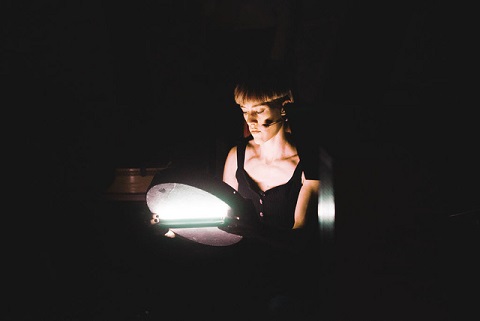 United States The Processing Series, Part I – ‘More Beautiful Than Words Can Tell’: Lucy Dhegrae (soprano), Nathaniel LaNasa (piano), Jerome Ellis (flute), Pala Garcia (violin), Amy Garapic (percussion). National Sawdust, Brooklyn, 23.11.2019. (RP)
United States The Processing Series, Part I – ‘More Beautiful Than Words Can Tell’: Lucy Dhegrae (soprano), Nathaniel LaNasa (piano), Jerome Ellis (flute), Pala Garcia (violin), Amy Garapic (percussion). National Sawdust, Brooklyn, 23.11.2019. (RP)

Jason Eckardt – Tongues: ‘Dithyramb’
Bethany Young – Her Disappearance
Vinko Globokar – ?Corporel
Maria Stankova – Rapana
Osnat Netzer – Philomelos (world premiere)
Caleb Burhans – no
It took time for soprano Lucy Dhegrae to find the beautiful in the trauma that she had suffered. As a freshman at the University of Michigan, Dhegrae had been drugged and raped by an All-American jock. Coming from a family of avid football fans and with her assailant denying the allegations, to say nothing of her conflicting feelings of shame, guilt and confusion, she kept quiet: a decision that eventually robbed Dhegrae of her ability to sing.
In ‘More Beautiful Than Words Can Tell’, the first concert in Dhegrae’s four-part series at National Sawdust exploring the relationship between mind and body, she addresses the struggle to articulate the experience of trauma. For the title of this concert, she looked to Walt Whitman’s ‘Song of the Open Road’ from Leaves of Grass (‘I swear to you there are divine things more beautiful than words can tell.’). In the poem, Whitman celebrates a journey where adventure beckons and a person can escape the past.
I saw this a few days after Akhnaten at the Metropolitan Opera, and it was striking to note the structural similarities between Dhegrae’s concept and Glass’s opera. Vocal works generally depend on text to generate emotion, but both Glass and Dhegrae rely primarily on sound, imagery and movement. In Akhnaten, Glass set texts in languages such as Egyptian, Akkadian and Hebrew for which no translations were provided. The emotional highpoint of the opera, however, is ’Hymn to the Sun’ which Glass instructed be sung in the language of the audience.
There was a similar arc to ‘More Beautiful Than Words Can Tell’. Dhegrae explored the ability to communicate beyond language through the works that she programmed. In most of the pieces, texts were either nonexistent or unintelligible, but Dhegrae intuited, as does Glass, that engaging the intellect, not just the senses and emotions, is required to totally connect with an audience at a higher level. Her equivalent to Glass’s ‘Hymn to the Sun’ was Osnat Netzer’s Philomelos, in which paraphrases from Shakespeare’s Titus Andronicus, on which it was based, were projected behind the performers.
Shakespeare’s Lavinia was raped on top of her husband’s dead body by two men who, to prevent her from identifying them, cut out her tongue and chopped off her hands. She ultimately identifies her attackers by drawing their names in the sand. The title of Netzer’s work refers to a figure in Greek mythology, Philomena, who suffered a similar fate. Dhegrae was joined by violinist Pala Garcia and percussionist Amy Garapic in this unsettling but strangely calming work in which Netzer based the interaction between the performers on Internal Family Systems Therapy. Intense, short scratchings from the violin coupled with the sound of shifting sand depicted the mutilated woman’s struggle to be heard.
The concert opened with Jason Eckardt’s ‘Dithyramb’, an ancient Greek hymn to Dionysus, the god of wine and pleasure. The work is an outburst of unintelligible vocal sounds that resemble spoken language. In 2013, after a performance of ‘Dithyramb’, Dhegrae lost her ability to sing. The diagnosis was paresis of the vocal cords, the definition of which was projected on a screen here, as was a video of her laryngoscopy.
The text to Bethany Young’s Her Disappearance for two voices was particularly troublesome in the context of this concert: ignoring a woman’s pleas for silence, her subsequently being robbed of her voice and her ultimate disappearance. It wasn’t intended to be fully comprehended, however, as Nathaniel LaNasa and Dhegrae sang it through long PVC pipes that rendered it into music but not song.
Vinko Globokar’s ?Corporel is a percussion work in which the performer uses his or her body to beat out the rhythms of this wordless piece. Here, Dhegrae used a wooden test dummy, and her initial curiosity, almost playfulness, turned to rage as she furiously pounded it. In contrast to the other works, Maria Stankova’s Rapana was dreamlike and soothing as performed by Dhegrae with Jerome Ellis on the flute. Caleb Burhans’s no was the final piece on the program. Dhegrae sang the two-letter word over and over again, until a sense of resolution was reached.
A tighter directorial reign would have yielded a more cogent theatrical experience with even greater emotional impact. Dhegrae served as curator, moderator and performer as well as director. The latter was one hat too many. Some scenes went on too long, while her foray into the audience to get audience members to read short texts sapped the energy out of the show. Someone in Dhegrae’s vast network should be able to do the job and kick ‘More Beautiful Than Words Can Tell’ up a notch to the higher level it deserves.
National Sawdust is in Williamsburg, a former industrial neighborhood in Brooklyn that is now the prototype for hip gentrification. By the twenty-first century, the National Sawdust Factory, which operated in the 1930s, was one of the few industrial buildings remaining in the area. It escaped demolition and was reincarnated as a state-of-the-art performance venue that opened in 2015 with a concert featuring Philip Glass and Nico Muhly.
National Sawdust is a safe space for new music and the musicians who perform it and the ideal venue for Lucy Dhegrae to embark upon her exploration of the nexus between mind and body. With ‘More Beautiful Than Words Can Tell’, Dhegrae has just begun to tell the story.
Rick Perdian